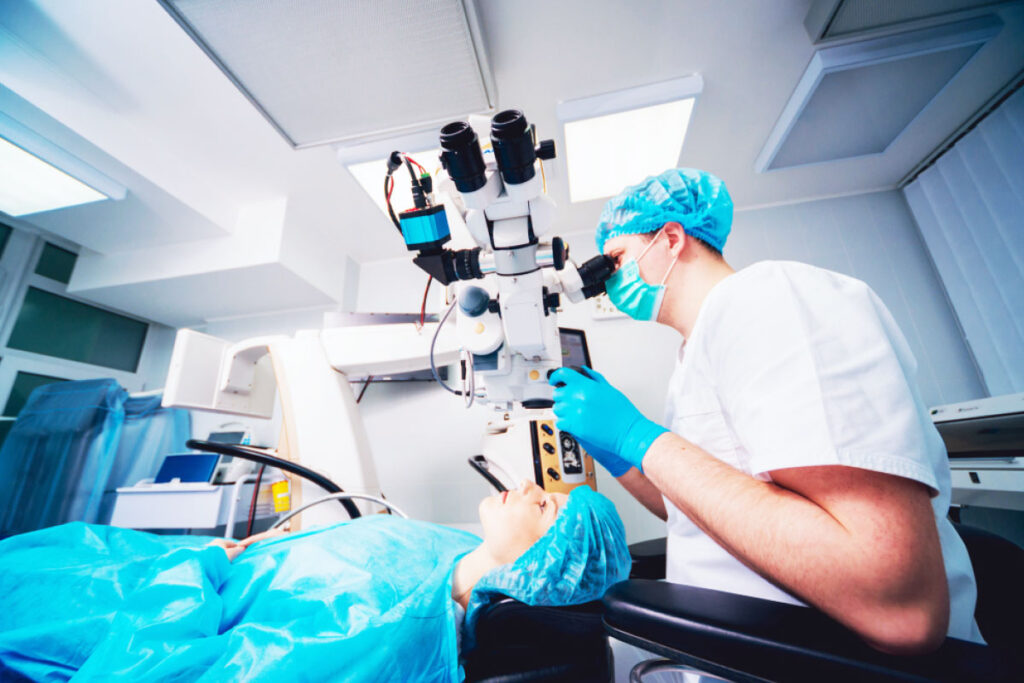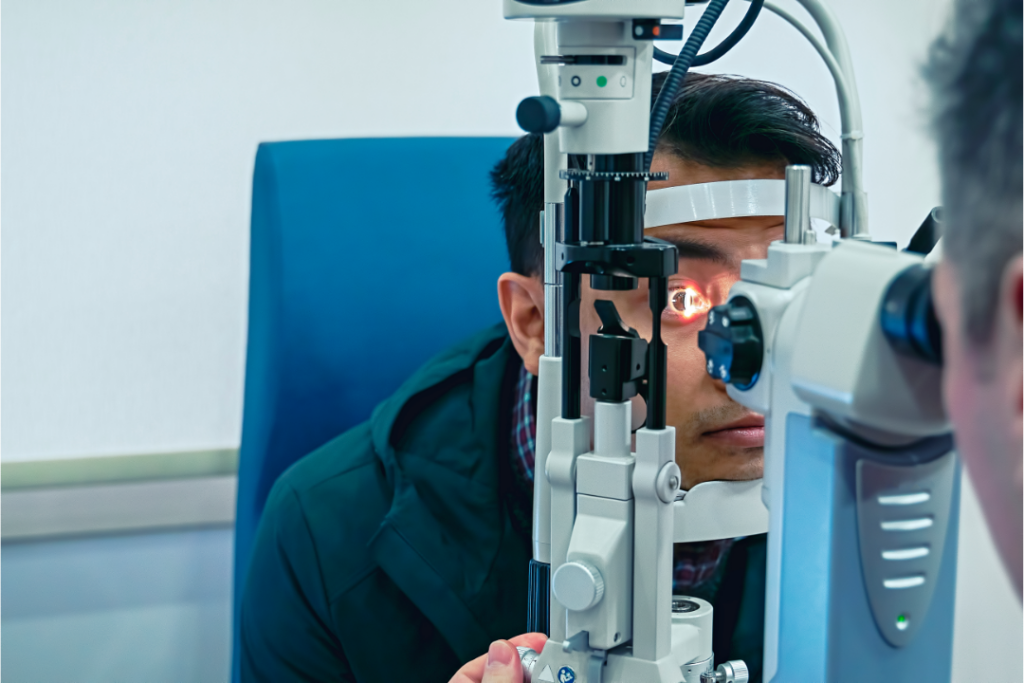Cataracts are a common eye condition that affects many people as they age. Over time, the lens of the eye becomes cloudy, leading to blurred vision and other visual disturbances. Fortunately, modern cataracts surgery offers effective treatment options that can significantly improve vision. In this article, we will explore the benefits of modern cataracts surgery and what to expect throughout the process.
Understanding Cataracts and Their Impact on Vision
Before delving into the benefits of modern cataracts surgery, it is important to understand what cataracts are and how they affect vision.
Cataracts occur when the proteins in the lens of the eye begin to clump together, clouding the normally clear lens. This clouding interferes with the passage of light entering the eye, leading to vision problems.
Imagine looking through a foggy window on a rainy day. The droplets of water on the glass obstruct your view, making everything appear blurry and distorted. Similarly, cataracts create a similar effect within the eye, causing vision to become hazy and unclear.
As cataracts progress, they can cause a range of visual symptoms. Blurred vision, increased sensitivity to glare, difficulty seeing at night, and faded colors are all common signs of cataracts. These symptoms can significantly impact one’s quality of life and daily activities.
Imagine trying to read your favorite book, but the words on the page appear fuzzy and indistinct. The enjoyment of reading is diminished, and the simple act of engaging with a story becomes a frustrating task. This is just one example of how cataracts can affect your vision. Also find more about Pre- and Post-Cataract Surgery Care: Tips for Optimal Recovery by clicking here.

Furthermore, cataracts can make it challenging to drive safely, especially at night. The glare from oncoming headlights can be blinding, making it difficult to see the road ahead clearly. This can not only put the individual with cataracts at risk but also endanger other drivers on the road.
Colors may also lose their vibrancy and appear washed out. Imagine looking at a beautiful sunset, but instead of witnessing the rich hues of oranges, pinks, and purples, everything appears dull and muted. The beauty of the world around you becomes less vibrant, impacting your overall visual experience.
It is important to recognize the impact that cataracts can have on an individual’s quality of life. Simple tasks such as reading, driving, and appreciating the beauty of the world can become challenging and frustrating. However, with advancements in modern cataract surgery, there is hope for restoring clear vision and improving overall quality of life.
The Evolution of Cataract Surgery
Over the years, cataract surgery techniques have evolved, leading to safer and more effective procedures. Let’s take a closer look at the fascinating journey of cataract surgery and how it has transformed over time.
Traditional Cataract Surgery Techniques
In the past, cataract surgery involved making a large incision in the eye and manually removing the clouded lens. This technique, known as extracapsular cataract extraction (ECCE), was the standard approach for many years. During the procedure, the surgeon would create a large incision, typically around 10-12mm, to gain access to the cataract-affected lens.
Once the incision was made, the surgeon would manually remove the lens, often in one piece. This process required a significant amount of force and skill, making it a challenging procedure for both the surgeon and the patient. Due to the large incision size, patients often experienced a longer recovery period and a higher risk of complications such as infection and astigmatism.
Despite its limitations, ECCE played a crucial role in treating cataracts and restoring vision for countless individuals. However, advancements in technology and surgical techniques paved the way for a more refined and less invasive approach.
The Advent of Modern Cataract Surgery
Modern cataract surgery techniques have revolutionized the treatment of cataracts. Today, the most common approach is phacoemulsification, which involves using ultrasound waves to break up the clouded lens and remove it through a small incision. This method is less invasive and leads to faster recovery times.
Phacoemulsification, often referred to as “phaco,” has transformed cataract surgery into a minimally invasive procedure. Instead of creating a large incision, the surgeon makes a tiny self-sealing incision, typically around 2-3mm, in the cornea. Through this small incision, a probe emitting ultrasound waves is inserted into the eye.
The ultrasound waves emitted by the probe break up the clouded lens into tiny fragments, which are then suctioned out of the eye. Once the cataract is removed, an artificial intraocular lens (IOL) is implanted to replace the natural lens and restore vision. The small incision size allows for a quicker healing process and reduces the risk of complications.
Advancements in phacoemulsification technology have further enhanced the precision and safety of the procedure. Surgeons now have access to advanced imaging systems that provide real-time visualization of the eye, allowing for more accurate incision placement and lens removal.
In addition to phacoemulsification, other modern techniques, such as laser-assisted cataract surgery, have emerged. Laser-assisted surgery utilizes laser technology to perform certain steps of the procedure, enhancing precision and reducing the risk of complications.
With each passing year, cataract surgery continues to evolve, driven by technological advancements and the pursuit of improved patient outcomes. The future holds even more exciting possibilities, including the development of innovative intraocular lenses and further refinements in surgical techniques.
As we look back at the evolution of cataract surgery, we can appreciate the remarkable progress made in the field. From the days of large incisions and manual lens removal to the era of minimally invasive procedures, cataract surgery has come a long way, offering renewed hope and improved vision for millions of people worldwide.

The Benefits of Modern Cataract Surgery
Modern cataract surgery offers various benefits that make it an attractive option for individuals with vision problems caused by cataracts. Cataracts are a common age-related condition that causes clouding of the lens in the eye, leading to blurred vision and difficulty seeing clearly. Fortunately, modern advancements in cataract surgery have revolutionized the treatment options available, providing patients with improved vision quality, faster recovery times, and minimally invasive procedures.
Improved Vision Quality
One of the most significant benefits of modern cataract surgery is the improvement in vision quality. By removing the clouded lens and replacing it with an artificial intraocular lens, patients often experience clearer and sharper vision. The artificial lens is designed to correct any refractive errors, such as nearsightedness or farsightedness, that the patient may have had prior to the surgery. As a result, colors appear brighter, and the overall visual experience is enhanced. Patients often report a significant improvement in their ability to see details and a reduction in the need for glasses or contact lenses.
Furthermore, modern cataract surgery techniques, such as laser-assisted cataract surgery, allow for precise and customized treatment. The use of lasers in cataract surgery enables surgeons to create precise incisions and break up the clouded lens with minimal trauma to the surrounding tissues. This precision contributes to better visual outcomes and enhances patient satisfaction.
Faster Recovery Times
Compared to traditional cataract surgery, modern techniques result in faster recovery times. With smaller incisions and advanced tools, the healing process is expedited, allowing patients to resume their daily activities sooner. In traditional cataract surgery, a larger incision is made to remove the clouded lens, which requires more time to heal. However, modern cataract surgery utilizes smaller incisions, often less than 3 millimeters in size, which reduces the risk of complications and promotes quicker healing.
Moreover, advancements in anesthesia techniques have also contributed to faster recovery times. Local anesthesia, such as eye drops or numbing injections, is commonly used in modern cataract surgery, eliminating the need for general anesthesia. This not only reduces the risks associated with general anesthesia but also allows patients to recover more quickly and return home on the same day as the surgery.

Minimally Invasive Procedures
Modern cataract surgery is considered minimally invasive, thanks to the small incision size and precise surgical techniques. The use of smaller incisions minimizes the disruption of the surrounding tissues, reducing the risk of complications and enhancing patient comfort during the procedure. The surgeon carefully removes the clouded lens through the small incision, ensuring minimal trauma to the eye.
Furthermore, advancements in surgical tools and technology have made modern cataract surgery even more precise and efficient. For example, the use of femtosecond lasers allows for the creation of precise incisions and the fragmentation of the clouded lens, making the surgery safer and more effective. Additionally, the use of advanced imaging systems, such as optical coherence tomography (OCT), enables surgeons to visualize the eye’s structures in real-time, ensuring accurate placement of the artificial lens.
In conclusion, modern cataract surgery offers numerous benefits that greatly improve the quality of life for individuals with cataracts. The advancements in technology and surgical techniques have revolutionized the treatment options available, providing patients with improved vision quality, faster recovery times, and minimally invasive procedures. If you are experiencing vision problems due to cataracts, it is advisable to consult with an ophthalmologist to discuss the benefits and suitability of modern cataract surgery for your specific needs.
Preparing for Cataract Surgery
Prior to undergoing cataract surgery, thorough preparation is essential to ensure optimal results. Cataract surgery is a common and highly successful procedure that involves removing the cloudy lens of the eye and replacing it with an artificial intraocular lens (IOL). This surgical intervention aims to improve vision and restore clarity.
While cataract surgery is generally safe and effective, it is crucial to go through a series of steps before the actual procedure to ensure the best possible outcome. Let’s take a closer look at the preparation process.
Initial Consultation and Eye Examination
During the initial consultation, an eye specialist will assess the extent of the cataracts and determine the most suitable treatment plan. This consultation is an opportunity for the patient to discuss any concerns or questions they may have. The eye specialist will carefully evaluate the patient’s medical history, including any pre-existing eye conditions, to ensure a comprehensive understanding of their unique eye health.
In addition to discussing the surgery itself, the eye specialist will conduct a thorough eye examination. This examination involves a series of tests to assess the overall health of the eyes, including visual acuity, intraocular pressure, and the presence of any other eye conditions. These tests help the specialist gather essential information to develop an individualized treatment plan.
Furthermore, during the initial consultation, measurements will be taken to determine the appropriate intraocular lens (IOL) power. These measurements are crucial for achieving the desired visual outcome after surgery. The eye specialist will use advanced technology to accurately calculate the power of the IOL, taking into account factors such as the patient’s corneal curvature and desired postoperative refractive error.
Choosing the Right Intraocular Lens
There are various types of intraocular lenses available, each with unique features. The surgeon will discuss the different options, taking into consideration factors such as lifestyle, visual needs, and any pre-existing eye conditions. The choice of the intraocular lens is an important decision that can significantly impact the patient’s visual outcome.
Some intraocular lenses are designed to correct astigmatism, while others offer multifocal capabilities, reducing the need for reading glasses or bifocals. The surgeon will carefully explain the benefits and potential limitations of each type of intraocular lens, empowering the patient to make an informed decision.
In addition to selecting the appropriate intraocular lens, the patient will also need to decide whether they prefer a monofocal or a premium lens. Monofocal lenses provide clear vision at a single distance, typically distance vision, while premium lenses offer a range of focus, allowing for improved vision at various distances.
During the consultation, the surgeon will guide the patient through this decision-making process, ensuring that the chosen intraocular lens aligns with their visual goals and lifestyle preferences.
Preparing for cataract surgery involves more than just the surgical procedure itself. It requires careful consideration of various factors, including the patient’s unique eye health, visual needs, and lifestyle. By undergoing a comprehensive initial consultation and examination, and selecting the most suitable intraocular lens, patients can maximize their chances of achieving optimal visual outcomes and enjoying a clearer, brighter future.
What to Expect During the Surgery
Cataract surgery is typically an outpatient procedure that is performed under local anesthesia. Here is a breakdown of what to expect during the surgery:
The Surgical Procedure Explained
The surgeon will create a small incision in the cornea and use ultrasound waves to break up and remove the cloudy lens. The natural lens is then replaced with an artificial intraocular lens that will restore clear vision.
Post-Surgery Care and Recovery
After the surgery, the eye will be protected with a shield or patch for a short period. Typically, patients experience some mild discomfort, which can be managed with prescribed eye drops and medication. It is important to follow all post-operative instructions provided by the surgeon for proper healing.In conclusion, modern cataract surgery offers numerous benefits, including improved vision quality, faster recovery times, and minimally invasive procedures. By understanding what to expect throughout the process, individuals can make informed decisions regarding their eye health. If you suspect cataracts or are experiencing vision problems, consult with an eye specialist to explore the available treatment options.


